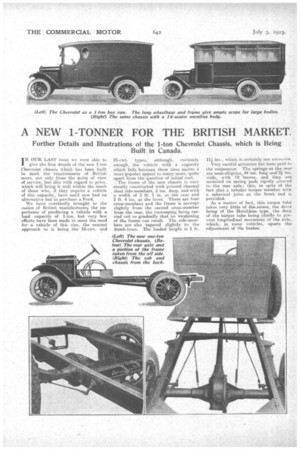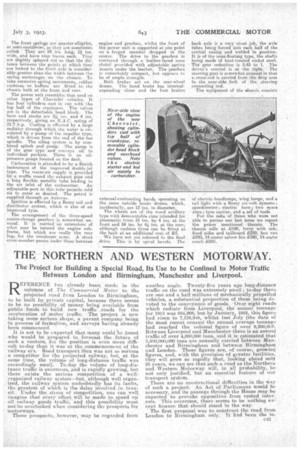A NEW 1-TONNER FOR THE BRITISH MARKET.
Page 32

Page 33

If you've noticed an error in this article please click here to report it so we can fix it.
Further Details and Illustrations of the 1-ton Chevrolet Chassis, which is Being Built in Canada.
I N OUR LAST issue we were able to
give the first details of the new lAon Chevrolet chassis which has been built to meet the requirements of British users, net only from the point of view of service, but also with regard to price; which will bring it, well within the reach of those Who, if they require a vehicle of this capacity, have until now had no alternative but to purchase a Ford.
We have constantly brought to the notice of British manufacturers the importance of producing a vehicle with a load capacity of 1-ton, but very few efforts have been made to meet the need for a vehicle of this size, the nearest approach to it being the 15-cwt. and 25-cwt.. types, although, curiously enough, the vehicle with a capacity which falls between these sine makes a inure popular appeal to many users, quite apart from the question of initial cost.
The frame ef the new chassis is very stoutly constructed with pressed channel steel side-members, 5 ins, deep, and with a width of 3 ft. 1 in. at. the io.ar and 2 ft. 4 ins, at the front. There are four cross-members and the frame is inswept slightly from the second cross-member from the rear, the insweeping being carried out so gradually that no weakening of the frame ean result. The side-mem.. hers are also tapered slightly to the dumb-irons. The loaded height is 1 ft.
111 ins., which is certainly not excessive.
Very careful attention has been paid to the suspension'. The springs-at the rear are semi-elliptics, 44 ins. long and'2i ins. wide, with 12 -leaves, and they are mounted on spring pads rigidly sccured to the rear axle; this, in spite of the fact that a tubular torque member vvith a spherical joint at the front, end is provided.
As a matter of fact, this torque tube takes very little of theestress, the drive being of the Hotchkiss type,. the duty of the torque tube being chiefly to prevent longitudinal movement of the axle, which, in some vehicles, upsets the adjustment of the brakes
. The front springs are quarter-ellipties, or sonti-centilefer, as they 'aro.sOnthtirries Tiiby -.6.r6--24 ins. long, wide, and have nine !eit.ve,s 'each. They• are slightly 'splayed oat so that the dis,tance between rthe points at Which they are locked to the -froiitaxle is 'considerably .greater than-the width between the spring. anchorages :onthe :chassis. To take excessive spring movements,. rubber cushions -or. buffers are fitted.. to,: the
chassis both at the front and rear. .
The power unit resembles t hat..used on other types of. -Chevrolet._ vehicles, It has four cylinders -cast in one with the top half of the crankcase. The valves. are in thedetachable head block. The bore. and stroke are 31t ins. and 4 ins respectively, giving an 6B.A.G, rating of 21.7.h.p. Cooling is effected by a large radiator through which the water is-eirculated by a 'pump of the impeller type, which is driven from the end of the fan spindle. The oiling system is by Cora.bined splash and pump. The pumpis ofthe gear type. and conveys oilto individual pockets. There is an oilpressure gauge located on the dash.
• Carburation is attended to by a Zenith instrument of the improved double-jet type. The..warrnAir supply is .provided by.a muffle round th exhaust pipe. and a long flexible metallic tube leading to the air inlet of the carburetter. An a.djustable port in this tube permits cold air to enter as desired. The petrol is supplied through an -Autovac.
Ignition is effected by a Remy coil and distributor system, which is also of an improved type.
The arrangement of the three-speed centre-change gearbox • is somewhat 'unusual. It • is carried on extensions of what may be termed the engine. subframe, but which are •really the rear lugs for the crankcase aims. A stout cross-member passes Under these between engineand g.earbox, whilst the ,front of the-power unit is supported at one point forged Member dropped in the centre. The drive to the gearbox is coniteyed through a leather-faced cone clutch proVided with adjustable spring inserts under the leather. The gearbox is remarkably et:impact, but appears to he of ample. strength,
. Both brakes act onthe rear-wheel drums. The hand brake has internalexpanding -shoes and the foot brakes
external-contracting bands operating on the same Outside brake drums, which, incidentally, are 12 ins, in diameter.
The wheels are of the wood artillery type with demountable rims intended for pneumatic tyres 51 ins. by 4 his, at the front and 34 ins. by 4i ins, at the roar, although cushion tyrese tan be fittest at the back at an additionel cost of £5.
We have not yet referred to the final drive. This • is by spiral bevels. The
back axle is a very. stout job, the axle tithes being forced into each half of the central casing and welded in position. It is of the semi-floating type, the shafts being made of heat-treated nickel steel. The gear reduction is 5.43 to 1. The driver's control is at the right. The steering gear is somewhat unusual in that a -crosS-rod is-carried from the drop arm to the near-side fork of the steering .connecting rod.
The equipment of the ehassis consists
of electric headlamps, wing lamps, and a tail light with a Remy six-volt dynamo; speedometer; electric horn ; two spare rims; tyre carrier, and a set of tools. For the sake of those erho were not able to peruse our last issue we repeat the prices mentioned therein. The Chassis sells at £190, lorry. with cab, fixed sides and tailboard £230, box van £245, 14-seater saloon bus £380, 14-seater coach £350.














































